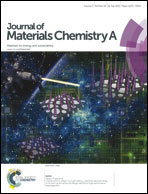Insight into lithium–metal anodes in lithium–sulfur batteries with a fluorinated ether electrolyte†
Abstract
High energy density Li–S batteries are a promising green battery chemistry, but polysulfide shuttling and lithium anode degradation hinder the practical use of Li–S batteries. Tremendous efforts have been made including confining sulfur in a closed cathode porous matrix and stabilizing lithium–metal anodes with additives; however, satisfactory confinement is challenging to achieve and electrolyte additives could be electrochemically unstable, deteriorating the long-term cyclability of Li–S batteries. Here, we demonstrate the control of polysulfide shuttling and stabilization of the lithium–metal anode with a fluorinated ether electrolyte without either cathode confinement or additives, which can be beneficial for both the efficient use of electrolytes and safe operation of Li–S batteries. Moreover, a solid-electrolyte interphase (SEI) layer with a hierarchical chemical composition of LiF and sulfate/sulfite/sulfide was identified on lithium anodes, which suppresses parasitic reactions and helps preserve the anode quality.


 Please wait while we load your content...
Please wait while we load your content...